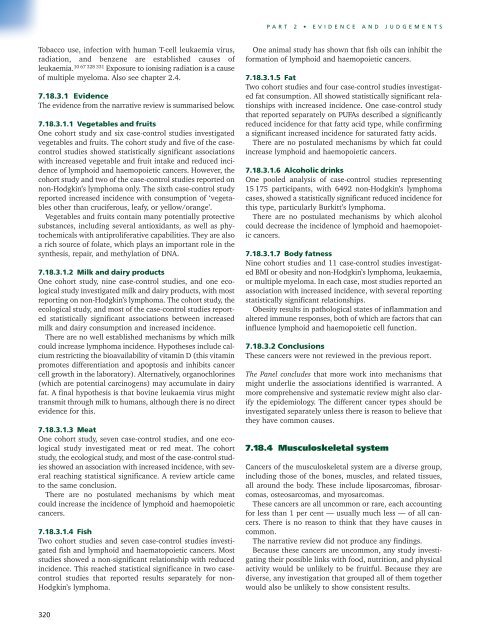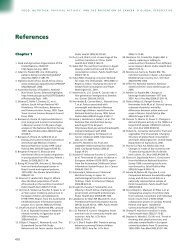Full Report - Food, Nutrition, and the Prevention of Cancer
Full Report - Food, Nutrition, and the Prevention of Cancer
Full Report - Food, Nutrition, and the Prevention of Cancer
Create successful ePaper yourself
Turn your PDF publications into a flip-book with our unique Google optimized e-Paper software.
Tobacco use, infection with human T-cell leukaemia virus,<br />
radiation, <strong>and</strong> benzene are established causes <strong>of</strong><br />
leukaemia. 10 67 328 331 Exposure to ionising radiation is a cause<br />
<strong>of</strong> multiple myeloma. Also see chapter 2.4.<br />
7.18.3.1 Evidence<br />
The evidence from <strong>the</strong> narrative review is summarised below.<br />
7.18.3.1.1 Vegetables <strong>and</strong> fruits<br />
One cohort study <strong>and</strong> six case-control studies investigated<br />
vegetables <strong>and</strong> fruits. The cohort study <strong>and</strong> five <strong>of</strong> <strong>the</strong> casecontrol<br />
studies showed statistically significant associations<br />
with increased vegetable <strong>and</strong> fruit intake <strong>and</strong> reduced incidence<br />
<strong>of</strong> lymphoid <strong>and</strong> haemopoietic cancers. However, <strong>the</strong><br />
cohort study <strong>and</strong> two <strong>of</strong> <strong>the</strong> case-control studies reported on<br />
non-Hodgkin’s lymphoma only. The sixth case-control study<br />
reported increased incidence with consumption <strong>of</strong> ‘vegetables<br />
o<strong>the</strong>r than cruciferous, leafy, or yellow/orange’.<br />
Vegetables <strong>and</strong> fruits contain many potentially protective<br />
substances, including several antioxidants, as well as phytochemicals<br />
with antiproliferative capabilities. They are also<br />
a rich source <strong>of</strong> folate, which plays an important role in <strong>the</strong><br />
syn<strong>the</strong>sis, repair, <strong>and</strong> methylation <strong>of</strong> DNA.<br />
7.18.3.1.2 Milk <strong>and</strong> dairy products<br />
One cohort study, nine case-control studies, <strong>and</strong> one ecological<br />
study investigated milk <strong>and</strong> dairy products, with most<br />
reporting on non-Hodgkin’s lymphoma. The cohort study, <strong>the</strong><br />
ecological study, <strong>and</strong> most <strong>of</strong> <strong>the</strong> case-control studies reported<br />
statistically significant associations between increased<br />
milk <strong>and</strong> dairy consumption <strong>and</strong> increased incidence.<br />
There are no well established mechanisms by which milk<br />
could increase lymphoma incidence. Hypo<strong>the</strong>ses include calcium<br />
restricting <strong>the</strong> bioavailability <strong>of</strong> vitamin D (this vitamin<br />
promotes differentiation <strong>and</strong> apoptosis <strong>and</strong> inhibits cancer<br />
cell growth in <strong>the</strong> laboratory). Alternatively, organochlorines<br />
(which are potential carcinogens) may accumulate in dairy<br />
fat. A final hypo<strong>the</strong>sis is that bovine leukaemia virus might<br />
transmit through milk to humans, although <strong>the</strong>re is no direct<br />
evidence for this.<br />
7.18.3.1.3 Meat<br />
One cohort study, seven case-control studies, <strong>and</strong> one ecological<br />
study investigated meat or red meat. The cohort<br />
study, <strong>the</strong> ecological study, <strong>and</strong> most <strong>of</strong> <strong>the</strong> case-control studies<br />
showed an association with increased incidence, with several<br />
reaching statistical significance. A review article came<br />
to <strong>the</strong> same conclusion.<br />
There are no postulated mechanisms by which meat<br />
could increase <strong>the</strong> incidence <strong>of</strong> lymphoid <strong>and</strong> haemopoietic<br />
cancers.<br />
7.18.3.1.4 Fish<br />
Two cohort studies <strong>and</strong> seven case-control studies investigated<br />
fish <strong>and</strong> lymphoid <strong>and</strong> haematopoietic cancers. Most<br />
studies showed a non-significant relationship with reduced<br />
incidence. This reached statistical significance in two casecontrol<br />
studies that reported results separately for non-<br />
Hodgkin’s lymphoma.<br />
320<br />
P ART 2 • EVIDENCE AND JUDGEMENTS<br />
One animal study has shown that fish oils can inhibit <strong>the</strong><br />
formation <strong>of</strong> lymphoid <strong>and</strong> haemopoietic cancers.<br />
7.18.3.1.5 Fat<br />
Two cohort studies <strong>and</strong> four case-control studies investigated<br />
fat consumption. All showed statistically significant relationships<br />
with increased incidence. One case-control study<br />
that reported separately on PUFAs described a significantly<br />
reduced incidence for that fatty acid type, while confirming<br />
a significant increased incidence for saturated fatty acids.<br />
There are no postulated mechanisms by which fat could<br />
increase lymphoid <strong>and</strong> haemopoietic cancers.<br />
7.18.3.1.6 Alcoholic drinks<br />
One pooled analysis <strong>of</strong> case-control studies representing<br />
15 175 participants, with 6492 non-Hodgkin’s lymphoma<br />
cases, showed a statistically significant reduced incidence for<br />
this type, particularly Burkitt’s lymphoma.<br />
There are no postulated mechanisms by which alcohol<br />
could decrease <strong>the</strong> incidence <strong>of</strong> lymphoid <strong>and</strong> haemopoietic<br />
cancers.<br />
7.18.3.1.7 Body fatness<br />
Nine cohort studies <strong>and</strong> 11 case-control studies investigated<br />
BMI or obesity <strong>and</strong> non-Hodgkin’s lymphoma, leukaemia,<br />
or multiple myeloma. In each case, most studies reported an<br />
association with increased incidence, with several reporting<br />
statistically significant relationships.<br />
Obesity results in pathological states <strong>of</strong> inflammation <strong>and</strong><br />
altered immune responses, both <strong>of</strong> which are factors that can<br />
influence lymphoid <strong>and</strong> haemopoietic cell function.<br />
7.18.3.2 Conclusions<br />
These cancers were not reviewed in <strong>the</strong> previous report.<br />
The Panel concludes that more work into mechanisms that<br />
might underlie <strong>the</strong> associations identified is warranted. A<br />
more comprehensive <strong>and</strong> systematic review might also clarify<br />
<strong>the</strong> epidemiology. The different cancer types should be<br />
investigated separately unless <strong>the</strong>re is reason to believe that<br />
<strong>the</strong>y have common causes.<br />
7.18.4 Musculoskeletal system<br />
<strong>Cancer</strong>s <strong>of</strong> <strong>the</strong> musculoskeletal system are a diverse group,<br />
including those <strong>of</strong> <strong>the</strong> bones, muscles, <strong>and</strong> related tissues,<br />
all around <strong>the</strong> body. These include liposarcomas, fibrosarcomas,<br />
osteosarcomas, <strong>and</strong> myosarcomas.<br />
These cancers are all uncommon or rare, each accounting<br />
for less than 1 per cent — usually much less — <strong>of</strong> all cancers.<br />
There is no reason to think that <strong>the</strong>y have causes in<br />
common.<br />
The narrative review did not produce any findings.<br />
Because <strong>the</strong>se cancers are uncommon, any study investigating<br />
<strong>the</strong>ir possible links with food, nutrition, <strong>and</strong> physical<br />
activity would be unlikely to be fruitful. Because <strong>the</strong>y are<br />
diverse, any investigation that grouped all <strong>of</strong> <strong>the</strong>m toge<strong>the</strong>r<br />
would also be unlikely to show consistent results.



